PROJ6004 Contracts & Procurement Case Study: Royal Adelaide Hospital
VerifiedAdded on 2023/05/31
|12
|3205
|362
Report
AI Summary
This report provides a detailed analysis of the contracts and procurement processes involved in the New Royal Adelaide Hospital project, a public-private partnership in Australia. It examines the project's complexity, organizational aspects, governance, and key risks, including resource allocation, project cost, and delays. The report also explores strategies for mitigating these risks and identifies potential learnings, such as the importance of risk management strategies and effective team management. Furthermore, it summarizes key findings from the Auditor-General's report, highlighting best practices for contract and procurement management, and outlines the roles of the project manager and procurement manager. The reflection journal emphasizes the significance of public-private partnerships and the impact of contractual obligations on project success.

Running head: CONTRACTS AND PROCUREMENT
Contracts and Procurement
Name of the Student
Name of the University
Author Note
Contracts and Procurement
Name of the Student
Name of the University
Author Note
Paraphrase This Document
Need a fresh take? Get an instant paraphrase of this document with our AI Paraphraser
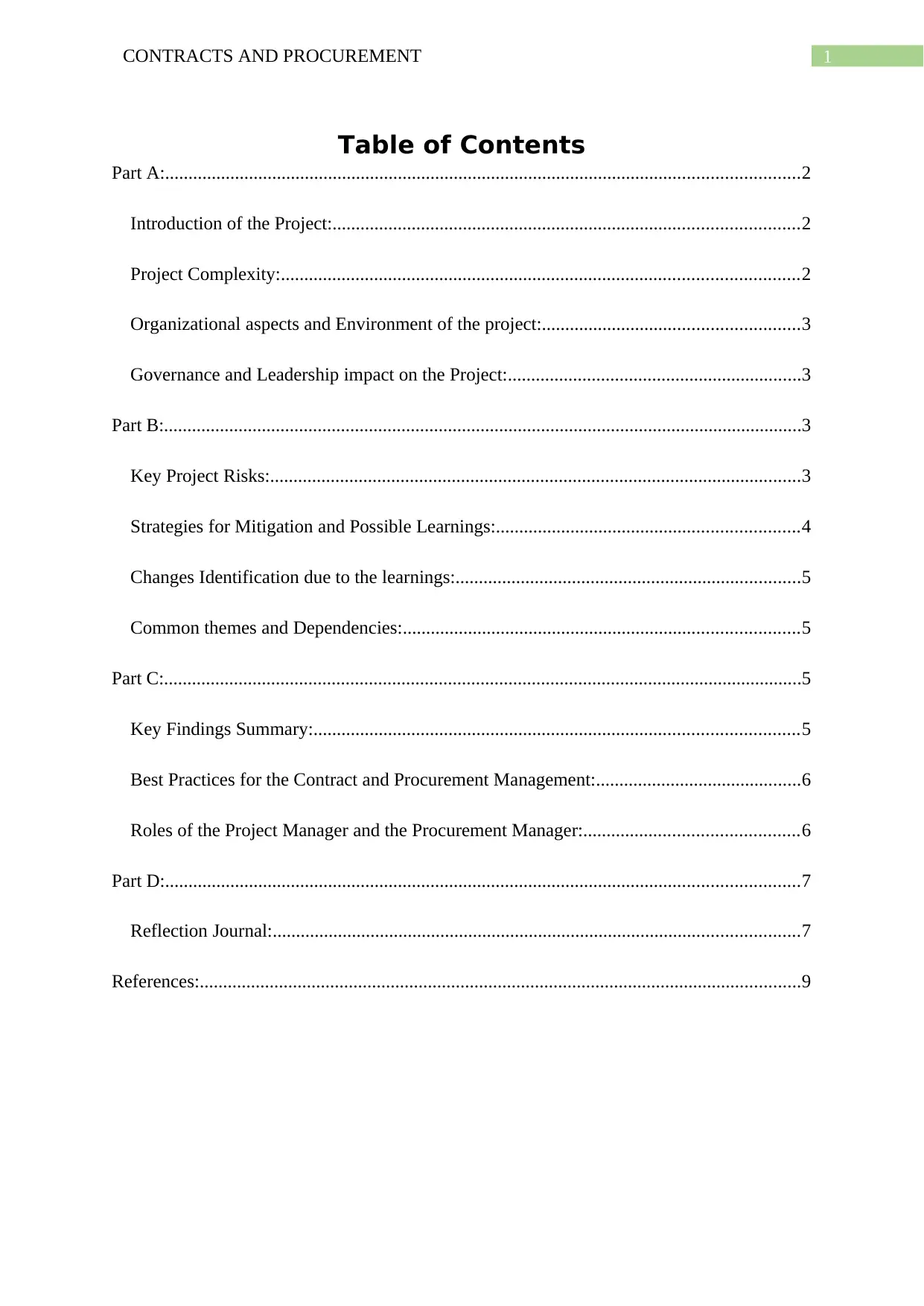
1CONTRACTS AND PROCUREMENT
Table of Contents
Part A:........................................................................................................................................2
Introduction of the Project:....................................................................................................2
Project Complexity:...............................................................................................................2
Organizational aspects and Environment of the project:.......................................................3
Governance and Leadership impact on the Project:...............................................................3
Part B:.........................................................................................................................................3
Key Project Risks:..................................................................................................................3
Strategies for Mitigation and Possible Learnings:.................................................................4
Changes Identification due to the learnings:..........................................................................5
Common themes and Dependencies:.....................................................................................5
Part C:.........................................................................................................................................5
Key Findings Summary:........................................................................................................5
Best Practices for the Contract and Procurement Management:............................................6
Roles of the Project Manager and the Procurement Manager:..............................................6
Part D:........................................................................................................................................7
Reflection Journal:.................................................................................................................7
References:.................................................................................................................................9
Table of Contents
Part A:........................................................................................................................................2
Introduction of the Project:....................................................................................................2
Project Complexity:...............................................................................................................2
Organizational aspects and Environment of the project:.......................................................3
Governance and Leadership impact on the Project:...............................................................3
Part B:.........................................................................................................................................3
Key Project Risks:..................................................................................................................3
Strategies for Mitigation and Possible Learnings:.................................................................4
Changes Identification due to the learnings:..........................................................................5
Common themes and Dependencies:.....................................................................................5
Part C:.........................................................................................................................................5
Key Findings Summary:........................................................................................................5
Best Practices for the Contract and Procurement Management:............................................6
Roles of the Project Manager and the Procurement Manager:..............................................6
Part D:........................................................................................................................................7
Reflection Journal:.................................................................................................................7
References:.................................................................................................................................9
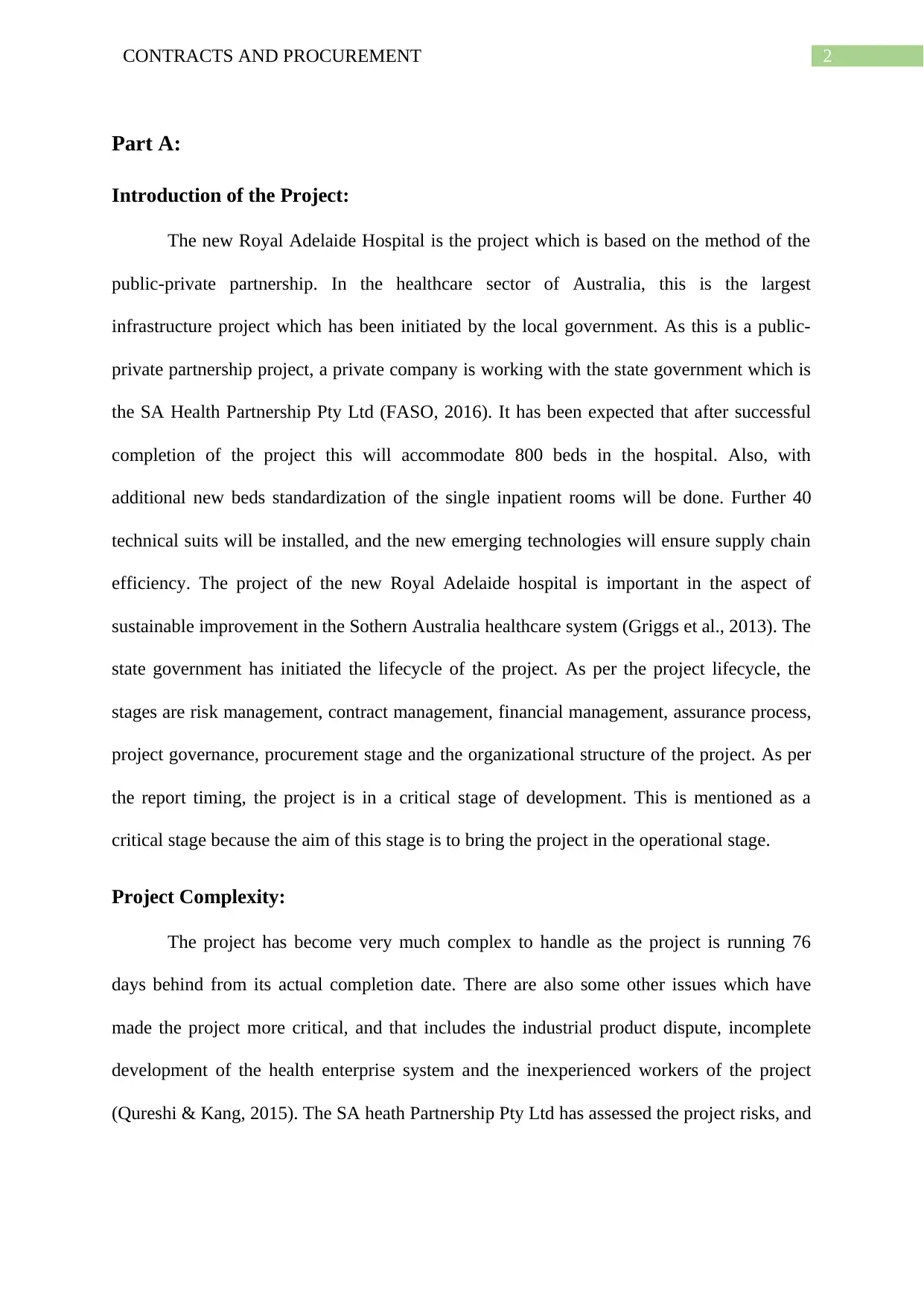
2CONTRACTS AND PROCUREMENT
Part A:
Introduction of the Project:
The new Royal Adelaide Hospital is the project which is based on the method of the
public-private partnership. In the healthcare sector of Australia, this is the largest
infrastructure project which has been initiated by the local government. As this is a public-
private partnership project, a private company is working with the state government which is
the SA Health Partnership Pty Ltd (FASO, 2016). It has been expected that after successful
completion of the project this will accommodate 800 beds in the hospital. Also, with
additional new beds standardization of the single inpatient rooms will be done. Further 40
technical suits will be installed, and the new emerging technologies will ensure supply chain
efficiency. The project of the new Royal Adelaide hospital is important in the aspect of
sustainable improvement in the Sothern Australia healthcare system (Griggs et al., 2013). The
state government has initiated the lifecycle of the project. As per the project lifecycle, the
stages are risk management, contract management, financial management, assurance process,
project governance, procurement stage and the organizational structure of the project. As per
the report timing, the project is in a critical stage of development. This is mentioned as a
critical stage because the aim of this stage is to bring the project in the operational stage.
Project Complexity:
The project has become very much complex to handle as the project is running 76
days behind from its actual completion date. There are also some other issues which have
made the project more critical, and that includes the industrial product dispute, incomplete
development of the health enterprise system and the inexperienced workers of the project
(Qureshi & Kang, 2015). The SA heath Partnership Pty Ltd has assessed the project risks, and
Part A:
Introduction of the Project:
The new Royal Adelaide Hospital is the project which is based on the method of the
public-private partnership. In the healthcare sector of Australia, this is the largest
infrastructure project which has been initiated by the local government. As this is a public-
private partnership project, a private company is working with the state government which is
the SA Health Partnership Pty Ltd (FASO, 2016). It has been expected that after successful
completion of the project this will accommodate 800 beds in the hospital. Also, with
additional new beds standardization of the single inpatient rooms will be done. Further 40
technical suits will be installed, and the new emerging technologies will ensure supply chain
efficiency. The project of the new Royal Adelaide hospital is important in the aspect of
sustainable improvement in the Sothern Australia healthcare system (Griggs et al., 2013). The
state government has initiated the lifecycle of the project. As per the project lifecycle, the
stages are risk management, contract management, financial management, assurance process,
project governance, procurement stage and the organizational structure of the project. As per
the report timing, the project is in a critical stage of development. This is mentioned as a
critical stage because the aim of this stage is to bring the project in the operational stage.
Project Complexity:
The project has become very much complex to handle as the project is running 76
days behind from its actual completion date. There are also some other issues which have
made the project more critical, and that includes the industrial product dispute, incomplete
development of the health enterprise system and the inexperienced workers of the project
(Qureshi & Kang, 2015). The SA heath Partnership Pty Ltd has assessed the project risks, and
⊘ This is a preview!⊘
Do you want full access?
Subscribe today to unlock all pages.

Trusted by 1+ million students worldwide
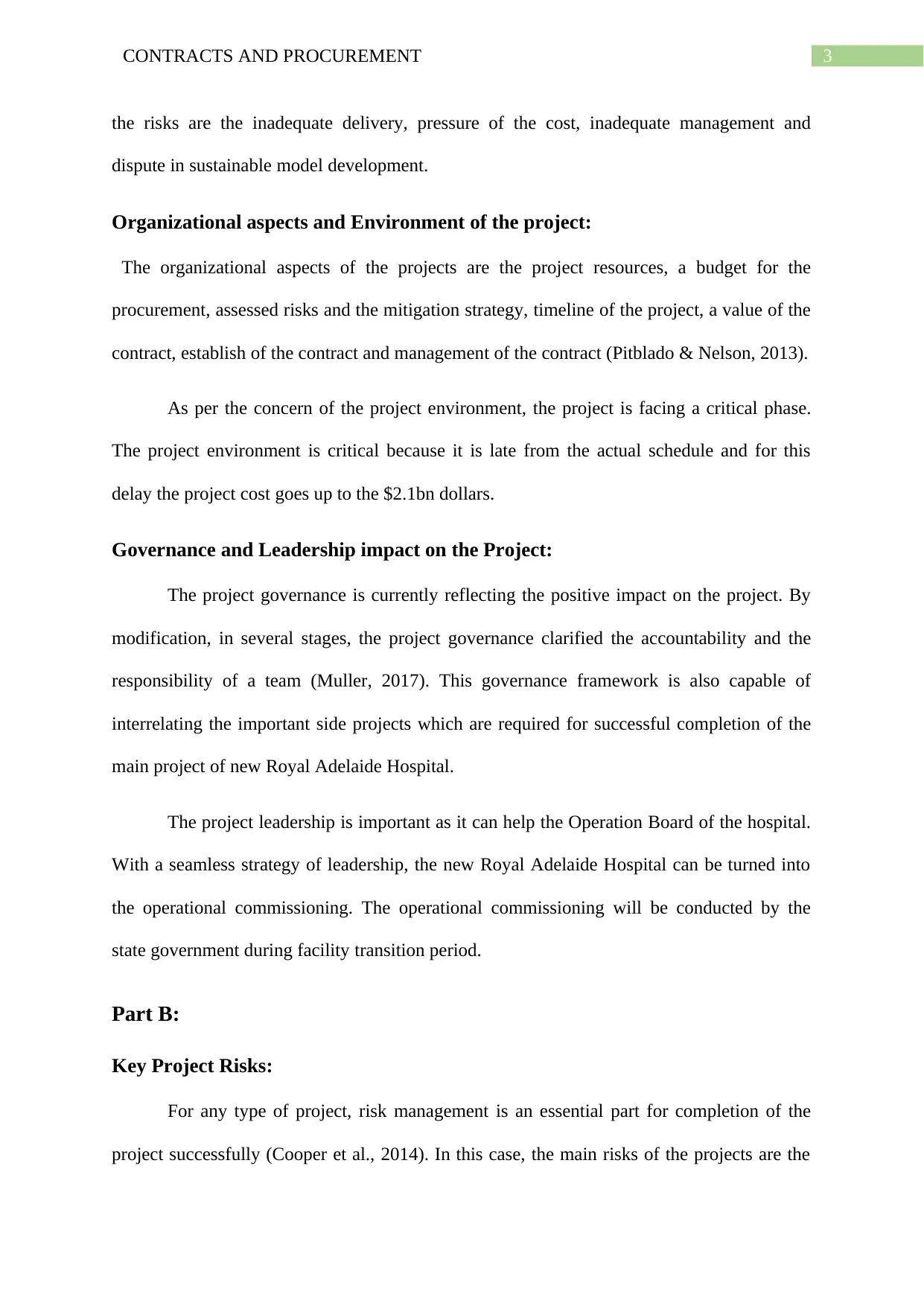
3CONTRACTS AND PROCUREMENT
the risks are the inadequate delivery, pressure of the cost, inadequate management and
dispute in sustainable model development.
Organizational aspects and Environment of the project:
The organizational aspects of the projects are the project resources, a budget for the
procurement, assessed risks and the mitigation strategy, timeline of the project, a value of the
contract, establish of the contract and management of the contract (Pitblado & Nelson, 2013).
As per the concern of the project environment, the project is facing a critical phase.
The project environment is critical because it is late from the actual schedule and for this
delay the project cost goes up to the $2.1bn dollars.
Governance and Leadership impact on the Project:
The project governance is currently reflecting the positive impact on the project. By
modification, in several stages, the project governance clarified the accountability and the
responsibility of a team (Muller, 2017). This governance framework is also capable of
interrelating the important side projects which are required for successful completion of the
main project of new Royal Adelaide Hospital.
The project leadership is important as it can help the Operation Board of the hospital.
With a seamless strategy of leadership, the new Royal Adelaide Hospital can be turned into
the operational commissioning. The operational commissioning will be conducted by the
state government during facility transition period.
Part B:
Key Project Risks:
For any type of project, risk management is an essential part for completion of the
project successfully (Cooper et al., 2014). In this case, the main risks of the projects are the
the risks are the inadequate delivery, pressure of the cost, inadequate management and
dispute in sustainable model development.
Organizational aspects and Environment of the project:
The organizational aspects of the projects are the project resources, a budget for the
procurement, assessed risks and the mitigation strategy, timeline of the project, a value of the
contract, establish of the contract and management of the contract (Pitblado & Nelson, 2013).
As per the concern of the project environment, the project is facing a critical phase.
The project environment is critical because it is late from the actual schedule and for this
delay the project cost goes up to the $2.1bn dollars.
Governance and Leadership impact on the Project:
The project governance is currently reflecting the positive impact on the project. By
modification, in several stages, the project governance clarified the accountability and the
responsibility of a team (Muller, 2017). This governance framework is also capable of
interrelating the important side projects which are required for successful completion of the
main project of new Royal Adelaide Hospital.
The project leadership is important as it can help the Operation Board of the hospital.
With a seamless strategy of leadership, the new Royal Adelaide Hospital can be turned into
the operational commissioning. The operational commissioning will be conducted by the
state government during facility transition period.
Part B:
Key Project Risks:
For any type of project, risk management is an essential part for completion of the
project successfully (Cooper et al., 2014). In this case, the main risks of the projects are the
Paraphrase This Document
Need a fresh take? Get an instant paraphrase of this document with our AI Paraphraser
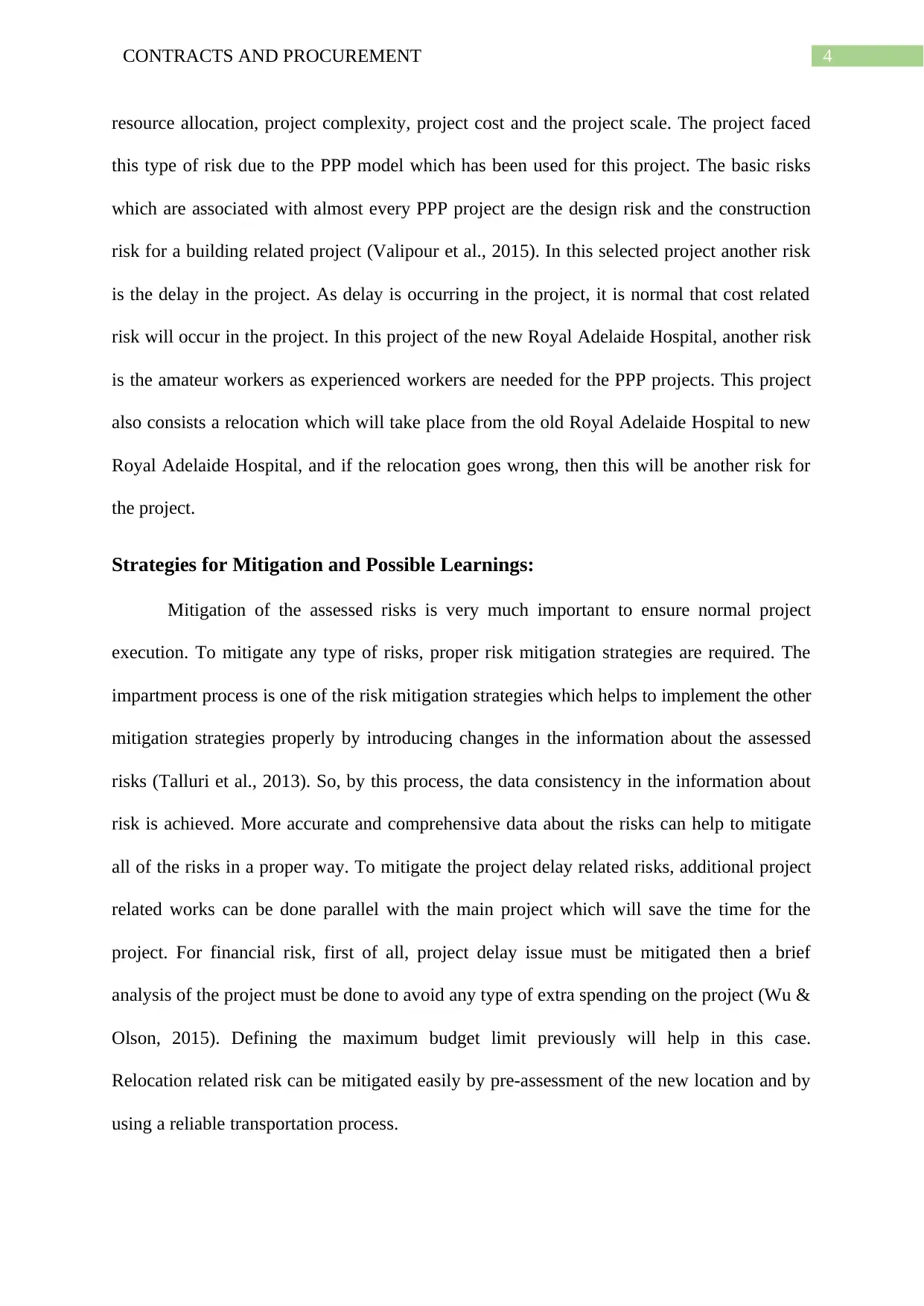
4CONTRACTS AND PROCUREMENT
resource allocation, project complexity, project cost and the project scale. The project faced
this type of risk due to the PPP model which has been used for this project. The basic risks
which are associated with almost every PPP project are the design risk and the construction
risk for a building related project (Valipour et al., 2015). In this selected project another risk
is the delay in the project. As delay is occurring in the project, it is normal that cost related
risk will occur in the project. In this project of the new Royal Adelaide Hospital, another risk
is the amateur workers as experienced workers are needed for the PPP projects. This project
also consists a relocation which will take place from the old Royal Adelaide Hospital to new
Royal Adelaide Hospital, and if the relocation goes wrong, then this will be another risk for
the project.
Strategies for Mitigation and Possible Learnings:
Mitigation of the assessed risks is very much important to ensure normal project
execution. To mitigate any type of risks, proper risk mitigation strategies are required. The
impartment process is one of the risk mitigation strategies which helps to implement the other
mitigation strategies properly by introducing changes in the information about the assessed
risks (Talluri et al., 2013). So, by this process, the data consistency in the information about
risk is achieved. More accurate and comprehensive data about the risks can help to mitigate
all of the risks in a proper way. To mitigate the project delay related risks, additional project
related works can be done parallel with the main project which will save the time for the
project. For financial risk, first of all, project delay issue must be mitigated then a brief
analysis of the project must be done to avoid any type of extra spending on the project (Wu &
Olson, 2015). Defining the maximum budget limit previously will help in this case.
Relocation related risk can be mitigated easily by pre-assessment of the new location and by
using a reliable transportation process.
resource allocation, project complexity, project cost and the project scale. The project faced
this type of risk due to the PPP model which has been used for this project. The basic risks
which are associated with almost every PPP project are the design risk and the construction
risk for a building related project (Valipour et al., 2015). In this selected project another risk
is the delay in the project. As delay is occurring in the project, it is normal that cost related
risk will occur in the project. In this project of the new Royal Adelaide Hospital, another risk
is the amateur workers as experienced workers are needed for the PPP projects. This project
also consists a relocation which will take place from the old Royal Adelaide Hospital to new
Royal Adelaide Hospital, and if the relocation goes wrong, then this will be another risk for
the project.
Strategies for Mitigation and Possible Learnings:
Mitigation of the assessed risks is very much important to ensure normal project
execution. To mitigate any type of risks, proper risk mitigation strategies are required. The
impartment process is one of the risk mitigation strategies which helps to implement the other
mitigation strategies properly by introducing changes in the information about the assessed
risks (Talluri et al., 2013). So, by this process, the data consistency in the information about
risk is achieved. More accurate and comprehensive data about the risks can help to mitigate
all of the risks in a proper way. To mitigate the project delay related risks, additional project
related works can be done parallel with the main project which will save the time for the
project. For financial risk, first of all, project delay issue must be mitigated then a brief
analysis of the project must be done to avoid any type of extra spending on the project (Wu &
Olson, 2015). Defining the maximum budget limit previously will help in this case.
Relocation related risk can be mitigated easily by pre-assessment of the new location and by
using a reliable transportation process.
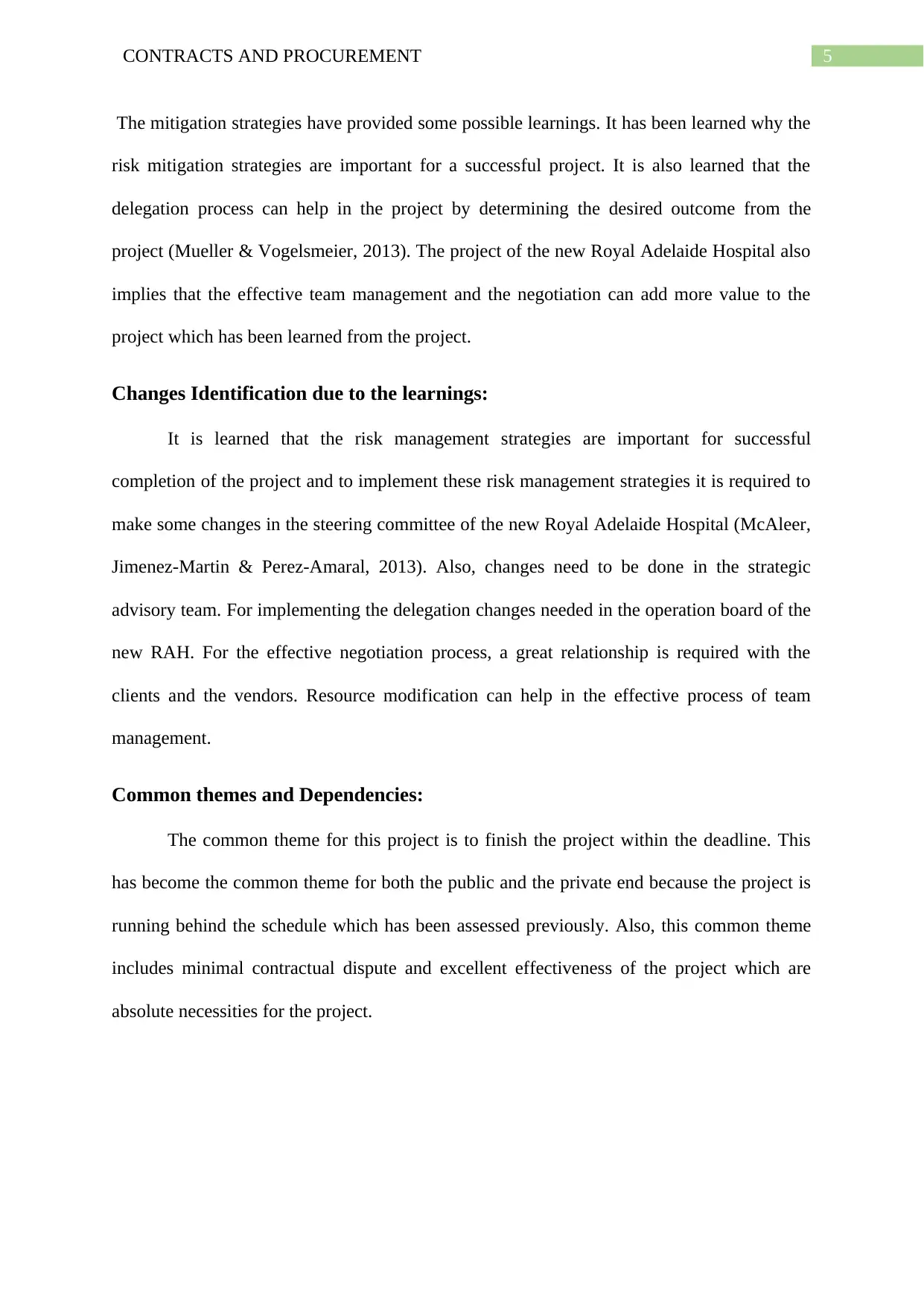
5CONTRACTS AND PROCUREMENT
The mitigation strategies have provided some possible learnings. It has been learned why the
risk mitigation strategies are important for a successful project. It is also learned that the
delegation process can help in the project by determining the desired outcome from the
project (Mueller & Vogelsmeier, 2013). The project of the new Royal Adelaide Hospital also
implies that the effective team management and the negotiation can add more value to the
project which has been learned from the project.
Changes Identification due to the learnings:
It is learned that the risk management strategies are important for successful
completion of the project and to implement these risk management strategies it is required to
make some changes in the steering committee of the new Royal Adelaide Hospital (McAleer,
Jimenez-Martin & Perez-Amaral, 2013). Also, changes need to be done in the strategic
advisory team. For implementing the delegation changes needed in the operation board of the
new RAH. For the effective negotiation process, a great relationship is required with the
clients and the vendors. Resource modification can help in the effective process of team
management.
Common themes and Dependencies:
The common theme for this project is to finish the project within the deadline. This
has become the common theme for both the public and the private end because the project is
running behind the schedule which has been assessed previously. Also, this common theme
includes minimal contractual dispute and excellent effectiveness of the project which are
absolute necessities for the project.
The mitigation strategies have provided some possible learnings. It has been learned why the
risk mitigation strategies are important for a successful project. It is also learned that the
delegation process can help in the project by determining the desired outcome from the
project (Mueller & Vogelsmeier, 2013). The project of the new Royal Adelaide Hospital also
implies that the effective team management and the negotiation can add more value to the
project which has been learned from the project.
Changes Identification due to the learnings:
It is learned that the risk management strategies are important for successful
completion of the project and to implement these risk management strategies it is required to
make some changes in the steering committee of the new Royal Adelaide Hospital (McAleer,
Jimenez-Martin & Perez-Amaral, 2013). Also, changes need to be done in the strategic
advisory team. For implementing the delegation changes needed in the operation board of the
new RAH. For the effective negotiation process, a great relationship is required with the
clients and the vendors. Resource modification can help in the effective process of team
management.
Common themes and Dependencies:
The common theme for this project is to finish the project within the deadline. This
has become the common theme for both the public and the private end because the project is
running behind the schedule which has been assessed previously. Also, this common theme
includes minimal contractual dispute and excellent effectiveness of the project which are
absolute necessities for the project.
⊘ This is a preview!⊘
Do you want full access?
Subscribe today to unlock all pages.

Trusted by 1+ million students worldwide
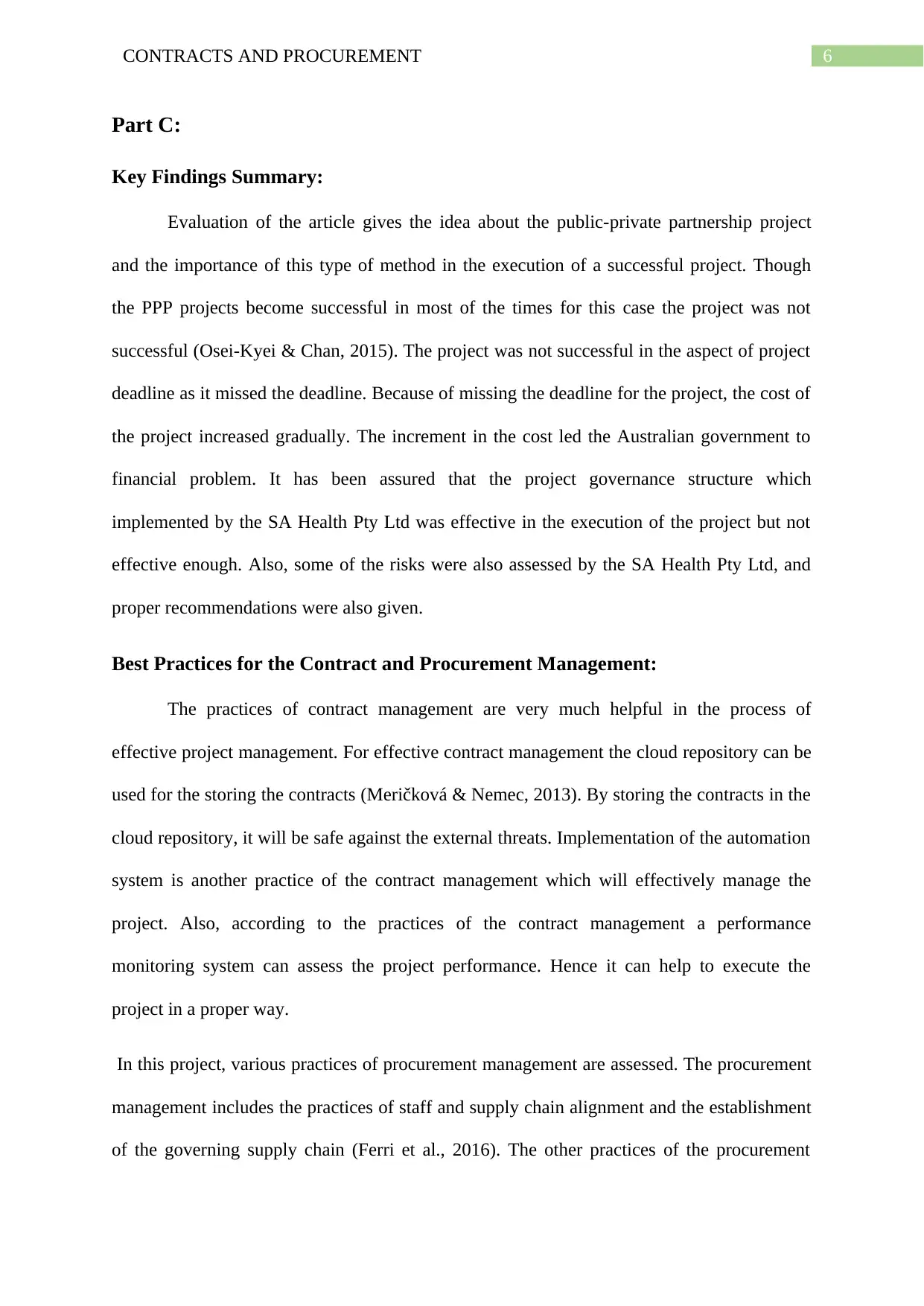
6CONTRACTS AND PROCUREMENT
Part C:
Key Findings Summary:
Evaluation of the article gives the idea about the public-private partnership project
and the importance of this type of method in the execution of a successful project. Though
the PPP projects become successful in most of the times for this case the project was not
successful (Osei-Kyei & Chan, 2015). The project was not successful in the aspect of project
deadline as it missed the deadline. Because of missing the deadline for the project, the cost of
the project increased gradually. The increment in the cost led the Australian government to
financial problem. It has been assured that the project governance structure which
implemented by the SA Health Pty Ltd was effective in the execution of the project but not
effective enough. Also, some of the risks were also assessed by the SA Health Pty Ltd, and
proper recommendations were also given.
Best Practices for the Contract and Procurement Management:
The practices of contract management are very much helpful in the process of
effective project management. For effective contract management the cloud repository can be
used for the storing the contracts (Meričková & Nemec, 2013). By storing the contracts in the
cloud repository, it will be safe against the external threats. Implementation of the automation
system is another practice of the contract management which will effectively manage the
project. Also, according to the practices of the contract management a performance
monitoring system can assess the project performance. Hence it can help to execute the
project in a proper way.
In this project, various practices of procurement management are assessed. The procurement
management includes the practices of staff and supply chain alignment and the establishment
of the governing supply chain (Ferri et al., 2016). The other practices of the procurement
Part C:
Key Findings Summary:
Evaluation of the article gives the idea about the public-private partnership project
and the importance of this type of method in the execution of a successful project. Though
the PPP projects become successful in most of the times for this case the project was not
successful (Osei-Kyei & Chan, 2015). The project was not successful in the aspect of project
deadline as it missed the deadline. Because of missing the deadline for the project, the cost of
the project increased gradually. The increment in the cost led the Australian government to
financial problem. It has been assured that the project governance structure which
implemented by the SA Health Pty Ltd was effective in the execution of the project but not
effective enough. Also, some of the risks were also assessed by the SA Health Pty Ltd, and
proper recommendations were also given.
Best Practices for the Contract and Procurement Management:
The practices of contract management are very much helpful in the process of
effective project management. For effective contract management the cloud repository can be
used for the storing the contracts (Meričková & Nemec, 2013). By storing the contracts in the
cloud repository, it will be safe against the external threats. Implementation of the automation
system is another practice of the contract management which will effectively manage the
project. Also, according to the practices of the contract management a performance
monitoring system can assess the project performance. Hence it can help to execute the
project in a proper way.
In this project, various practices of procurement management are assessed. The procurement
management includes the practices of staff and supply chain alignment and the establishment
of the governing supply chain (Ferri et al., 2016). The other practices of the procurement
Paraphrase This Document
Need a fresh take? Get an instant paraphrase of this document with our AI Paraphraser
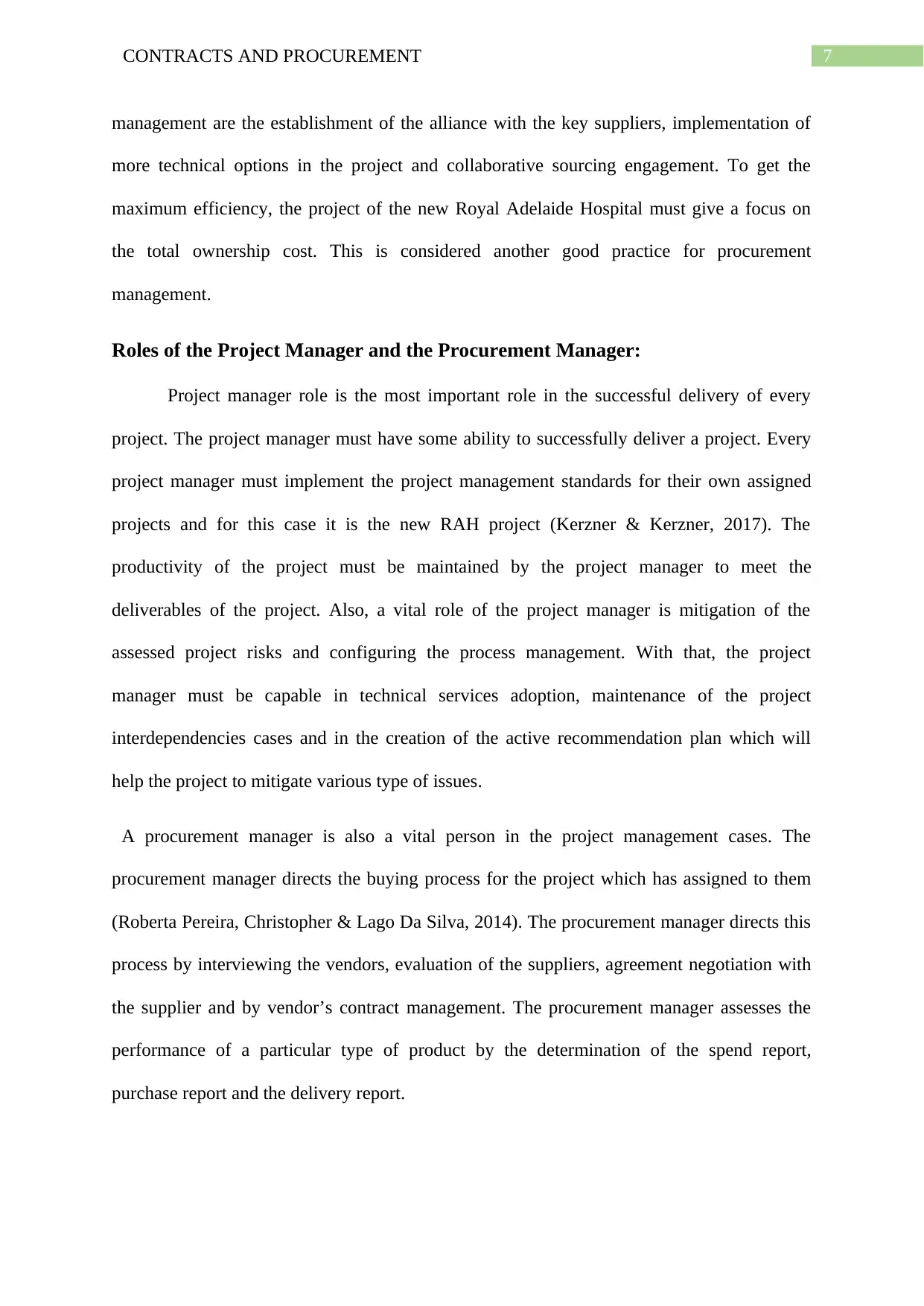
7CONTRACTS AND PROCUREMENT
management are the establishment of the alliance with the key suppliers, implementation of
more technical options in the project and collaborative sourcing engagement. To get the
maximum efficiency, the project of the new Royal Adelaide Hospital must give a focus on
the total ownership cost. This is considered another good practice for procurement
management.
Roles of the Project Manager and the Procurement Manager:
Project manager role is the most important role in the successful delivery of every
project. The project manager must have some ability to successfully deliver a project. Every
project manager must implement the project management standards for their own assigned
projects and for this case it is the new RAH project (Kerzner & Kerzner, 2017). The
productivity of the project must be maintained by the project manager to meet the
deliverables of the project. Also, a vital role of the project manager is mitigation of the
assessed project risks and configuring the process management. With that, the project
manager must be capable in technical services adoption, maintenance of the project
interdependencies cases and in the creation of the active recommendation plan which will
help the project to mitigate various type of issues.
A procurement manager is also a vital person in the project management cases. The
procurement manager directs the buying process for the project which has assigned to them
(Roberta Pereira, Christopher & Lago Da Silva, 2014). The procurement manager directs this
process by interviewing the vendors, evaluation of the suppliers, agreement negotiation with
the supplier and by vendor’s contract management. The procurement manager assesses the
performance of a particular type of product by the determination of the spend report,
purchase report and the delivery report.
management are the establishment of the alliance with the key suppliers, implementation of
more technical options in the project and collaborative sourcing engagement. To get the
maximum efficiency, the project of the new Royal Adelaide Hospital must give a focus on
the total ownership cost. This is considered another good practice for procurement
management.
Roles of the Project Manager and the Procurement Manager:
Project manager role is the most important role in the successful delivery of every
project. The project manager must have some ability to successfully deliver a project. Every
project manager must implement the project management standards for their own assigned
projects and for this case it is the new RAH project (Kerzner & Kerzner, 2017). The
productivity of the project must be maintained by the project manager to meet the
deliverables of the project. Also, a vital role of the project manager is mitigation of the
assessed project risks and configuring the process management. With that, the project
manager must be capable in technical services adoption, maintenance of the project
interdependencies cases and in the creation of the active recommendation plan which will
help the project to mitigate various type of issues.
A procurement manager is also a vital person in the project management cases. The
procurement manager directs the buying process for the project which has assigned to them
(Roberta Pereira, Christopher & Lago Da Silva, 2014). The procurement manager directs this
process by interviewing the vendors, evaluation of the suppliers, agreement negotiation with
the supplier and by vendor’s contract management. The procurement manager assesses the
performance of a particular type of product by the determination of the spend report,
purchase report and the delivery report.
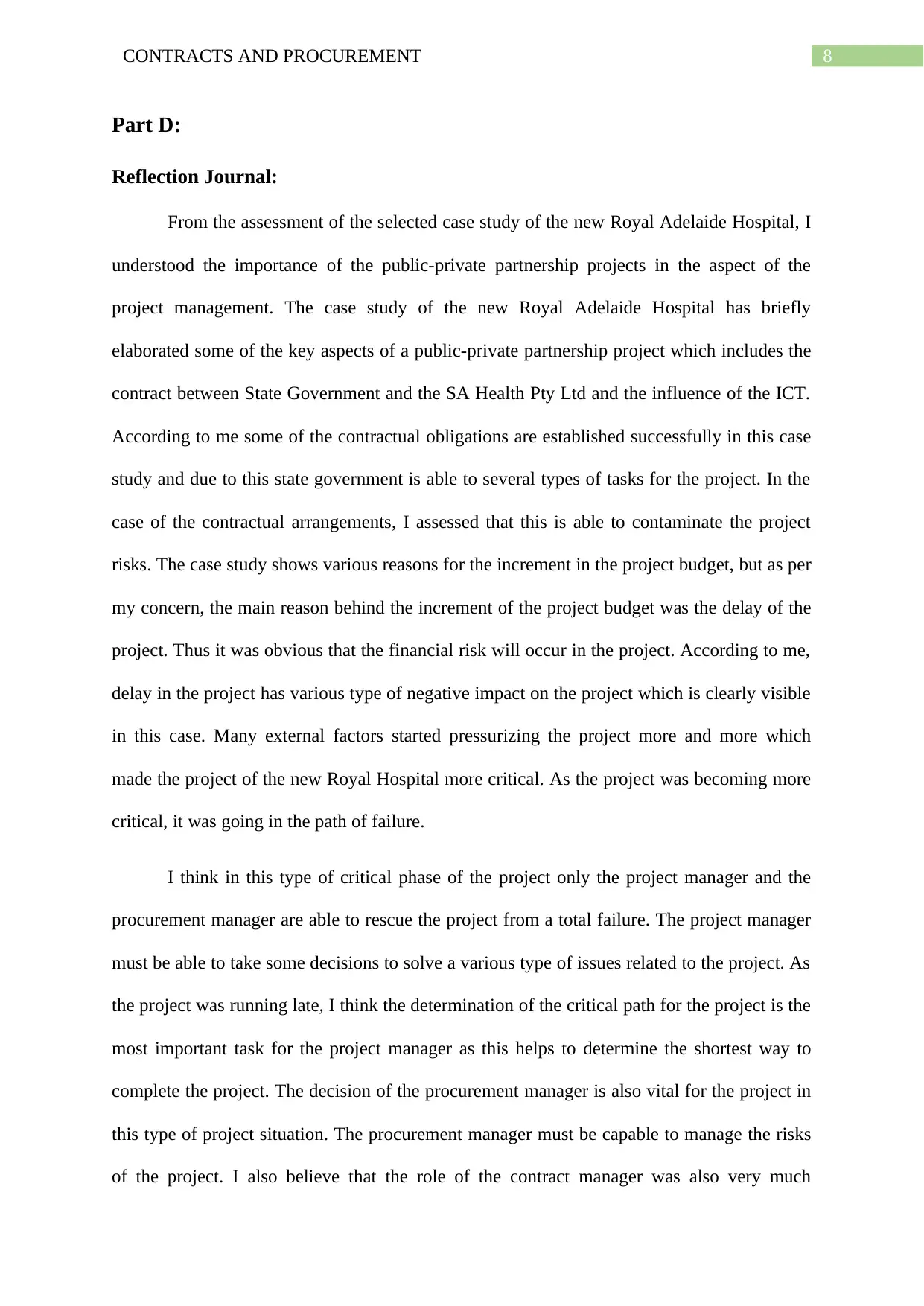
8CONTRACTS AND PROCUREMENT
Part D:
Reflection Journal:
From the assessment of the selected case study of the new Royal Adelaide Hospital, I
understood the importance of the public-private partnership projects in the aspect of the
project management. The case study of the new Royal Adelaide Hospital has briefly
elaborated some of the key aspects of a public-private partnership project which includes the
contract between State Government and the SA Health Pty Ltd and the influence of the ICT.
According to me some of the contractual obligations are established successfully in this case
study and due to this state government is able to several types of tasks for the project. In the
case of the contractual arrangements, I assessed that this is able to contaminate the project
risks. The case study shows various reasons for the increment in the project budget, but as per
my concern, the main reason behind the increment of the project budget was the delay of the
project. Thus it was obvious that the financial risk will occur in the project. According to me,
delay in the project has various type of negative impact on the project which is clearly visible
in this case. Many external factors started pressurizing the project more and more which
made the project of the new Royal Hospital more critical. As the project was becoming more
critical, it was going in the path of failure.
I think in this type of critical phase of the project only the project manager and the
procurement manager are able to rescue the project from a total failure. The project manager
must be able to take some decisions to solve a various type of issues related to the project. As
the project was running late, I think the determination of the critical path for the project is the
most important task for the project manager as this helps to determine the shortest way to
complete the project. The decision of the procurement manager is also vital for the project in
this type of project situation. The procurement manager must be capable to manage the risks
of the project. I also believe that the role of the contract manager was also very much
Part D:
Reflection Journal:
From the assessment of the selected case study of the new Royal Adelaide Hospital, I
understood the importance of the public-private partnership projects in the aspect of the
project management. The case study of the new Royal Adelaide Hospital has briefly
elaborated some of the key aspects of a public-private partnership project which includes the
contract between State Government and the SA Health Pty Ltd and the influence of the ICT.
According to me some of the contractual obligations are established successfully in this case
study and due to this state government is able to several types of tasks for the project. In the
case of the contractual arrangements, I assessed that this is able to contaminate the project
risks. The case study shows various reasons for the increment in the project budget, but as per
my concern, the main reason behind the increment of the project budget was the delay of the
project. Thus it was obvious that the financial risk will occur in the project. According to me,
delay in the project has various type of negative impact on the project which is clearly visible
in this case. Many external factors started pressurizing the project more and more which
made the project of the new Royal Hospital more critical. As the project was becoming more
critical, it was going in the path of failure.
I think in this type of critical phase of the project only the project manager and the
procurement manager are able to rescue the project from a total failure. The project manager
must be able to take some decisions to solve a various type of issues related to the project. As
the project was running late, I think the determination of the critical path for the project is the
most important task for the project manager as this helps to determine the shortest way to
complete the project. The decision of the procurement manager is also vital for the project in
this type of project situation. The procurement manager must be capable to manage the risks
of the project. I also believe that the role of the contract manager was also very much
⊘ This is a preview!⊘
Do you want full access?
Subscribe today to unlock all pages.

Trusted by 1+ million students worldwide
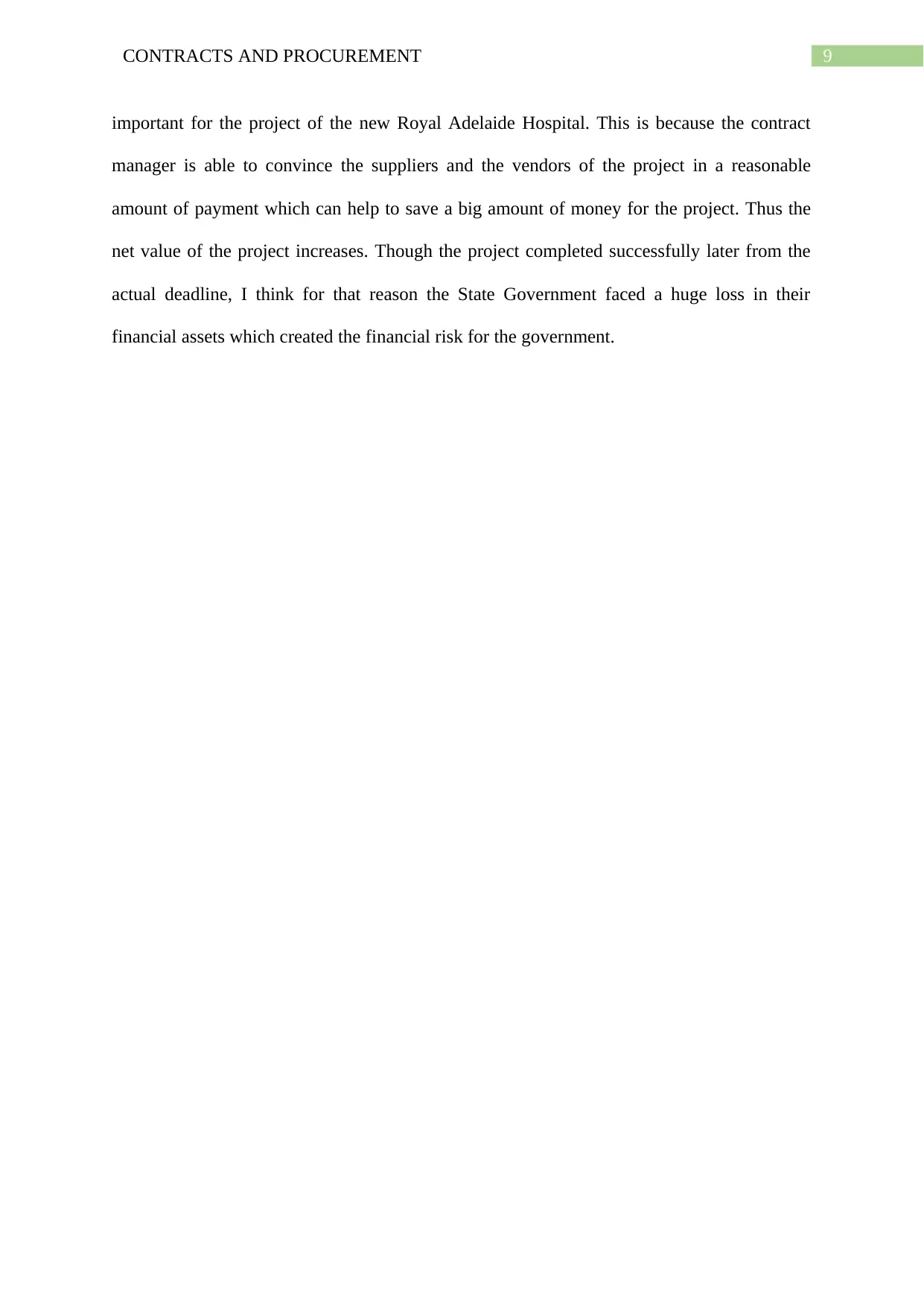
9CONTRACTS AND PROCUREMENT
important for the project of the new Royal Adelaide Hospital. This is because the contract
manager is able to convince the suppliers and the vendors of the project in a reasonable
amount of payment which can help to save a big amount of money for the project. Thus the
net value of the project increases. Though the project completed successfully later from the
actual deadline, I think for that reason the State Government faced a huge loss in their
financial assets which created the financial risk for the government.
important for the project of the new Royal Adelaide Hospital. This is because the contract
manager is able to convince the suppliers and the vendors of the project in a reasonable
amount of payment which can help to save a big amount of money for the project. Thus the
net value of the project increases. Though the project completed successfully later from the
actual deadline, I think for that reason the State Government faced a huge loss in their
financial assets which created the financial risk for the government.
Paraphrase This Document
Need a fresh take? Get an instant paraphrase of this document with our AI Paraphraser
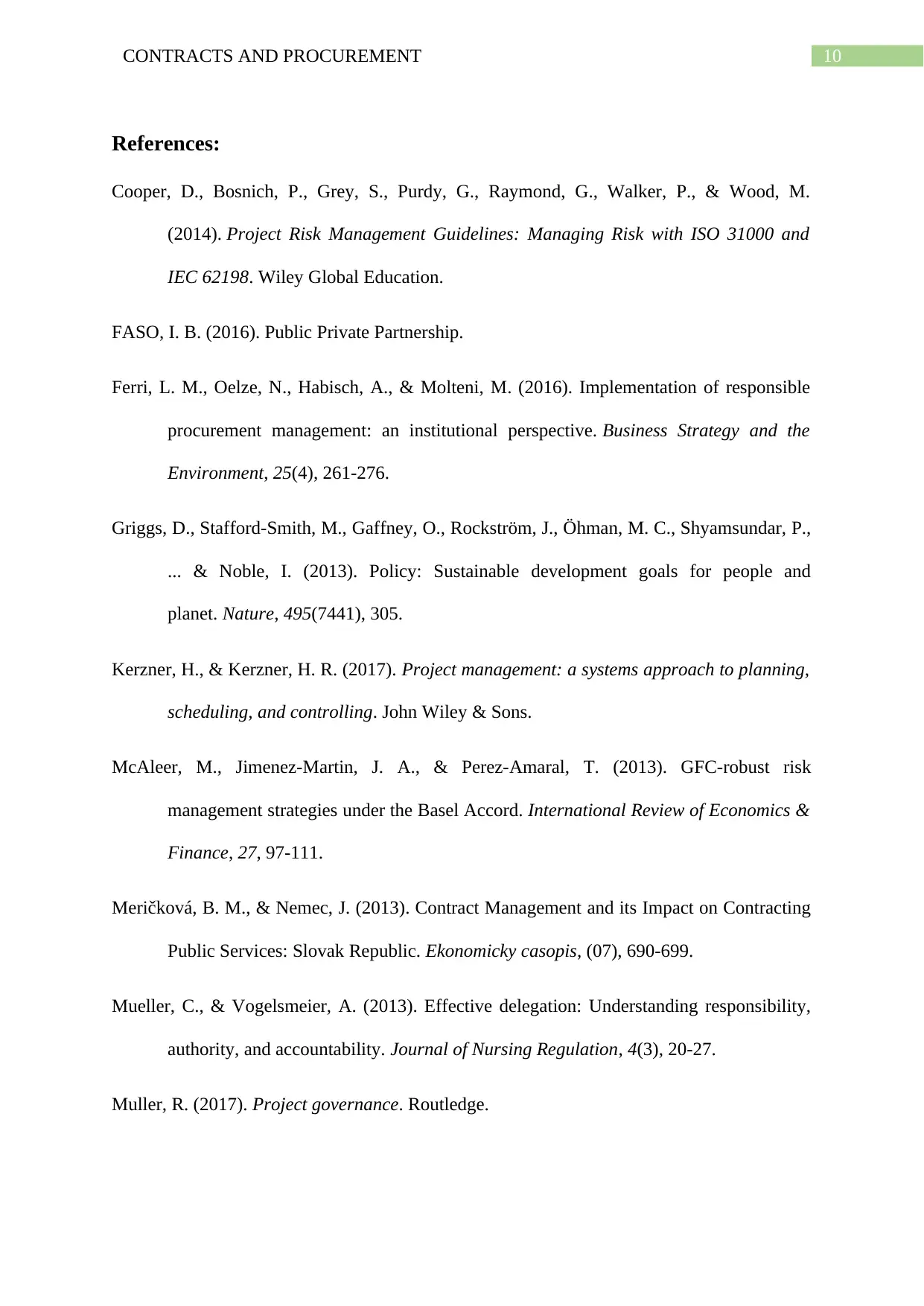
10CONTRACTS AND PROCUREMENT
References:
Cooper, D., Bosnich, P., Grey, S., Purdy, G., Raymond, G., Walker, P., & Wood, M.
(2014). Project Risk Management Guidelines: Managing Risk with ISO 31000 and
IEC 62198. Wiley Global Education.
FASO, I. B. (2016). Public Private Partnership.
Ferri, L. M., Oelze, N., Habisch, A., & Molteni, M. (2016). Implementation of responsible
procurement management: an institutional perspective. Business Strategy and the
Environment, 25(4), 261-276.
Griggs, D., Stafford-Smith, M., Gaffney, O., Rockström, J., Öhman, M. C., Shyamsundar, P.,
... & Noble, I. (2013). Policy: Sustainable development goals for people and
planet. Nature, 495(7441), 305.
Kerzner, H., & Kerzner, H. R. (2017). Project management: a systems approach to planning,
scheduling, and controlling. John Wiley & Sons.
McAleer, M., Jimenez-Martin, J. A., & Perez-Amaral, T. (2013). GFC-robust risk
management strategies under the Basel Accord. International Review of Economics &
Finance, 27, 97-111.
Meričková, B. M., & Nemec, J. (2013). Contract Management and its Impact on Contracting
Public Services: Slovak Republic. Ekonomicky casopis, (07), 690-699.
Mueller, C., & Vogelsmeier, A. (2013). Effective delegation: Understanding responsibility,
authority, and accountability. Journal of Nursing Regulation, 4(3), 20-27.
Muller, R. (2017). Project governance. Routledge.
References:
Cooper, D., Bosnich, P., Grey, S., Purdy, G., Raymond, G., Walker, P., & Wood, M.
(2014). Project Risk Management Guidelines: Managing Risk with ISO 31000 and
IEC 62198. Wiley Global Education.
FASO, I. B. (2016). Public Private Partnership.
Ferri, L. M., Oelze, N., Habisch, A., & Molteni, M. (2016). Implementation of responsible
procurement management: an institutional perspective. Business Strategy and the
Environment, 25(4), 261-276.
Griggs, D., Stafford-Smith, M., Gaffney, O., Rockström, J., Öhman, M. C., Shyamsundar, P.,
... & Noble, I. (2013). Policy: Sustainable development goals for people and
planet. Nature, 495(7441), 305.
Kerzner, H., & Kerzner, H. R. (2017). Project management: a systems approach to planning,
scheduling, and controlling. John Wiley & Sons.
McAleer, M., Jimenez-Martin, J. A., & Perez-Amaral, T. (2013). GFC-robust risk
management strategies under the Basel Accord. International Review of Economics &
Finance, 27, 97-111.
Meričková, B. M., & Nemec, J. (2013). Contract Management and its Impact on Contracting
Public Services: Slovak Republic. Ekonomicky casopis, (07), 690-699.
Mueller, C., & Vogelsmeier, A. (2013). Effective delegation: Understanding responsibility,
authority, and accountability. Journal of Nursing Regulation, 4(3), 20-27.
Muller, R. (2017). Project governance. Routledge.
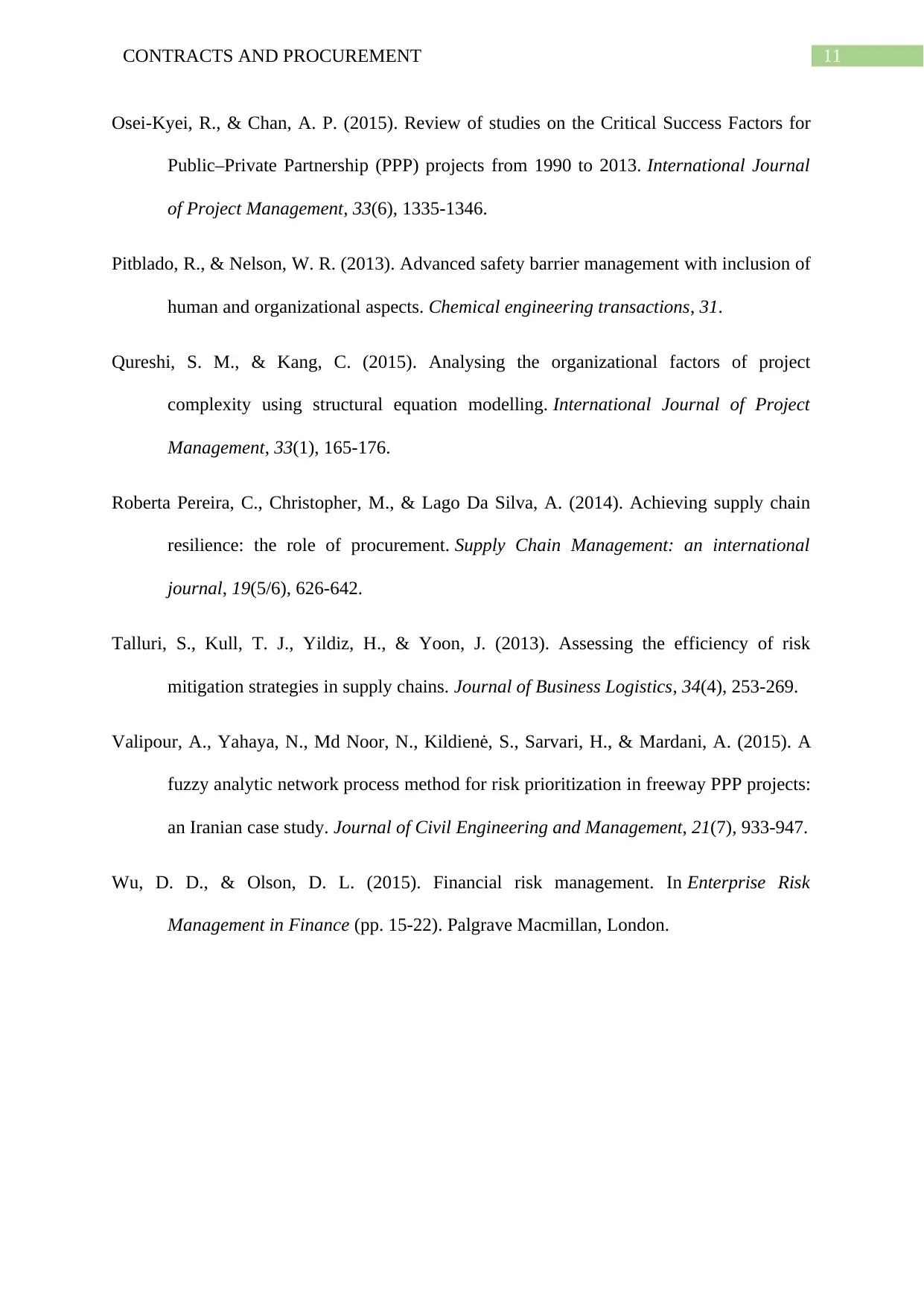
11CONTRACTS AND PROCUREMENT
Osei-Kyei, R., & Chan, A. P. (2015). Review of studies on the Critical Success Factors for
Public–Private Partnership (PPP) projects from 1990 to 2013. International Journal
of Project Management, 33(6), 1335-1346.
Pitblado, R., & Nelson, W. R. (2013). Advanced safety barrier management with inclusion of
human and organizational aspects. Chemical engineering transactions, 31.
Qureshi, S. M., & Kang, C. (2015). Analysing the organizational factors of project
complexity using structural equation modelling. International Journal of Project
Management, 33(1), 165-176.
Roberta Pereira, C., Christopher, M., & Lago Da Silva, A. (2014). Achieving supply chain
resilience: the role of procurement. Supply Chain Management: an international
journal, 19(5/6), 626-642.
Talluri, S., Kull, T. J., Yildiz, H., & Yoon, J. (2013). Assessing the efficiency of risk
mitigation strategies in supply chains. Journal of Business Logistics, 34(4), 253-269.
Valipour, A., Yahaya, N., Md Noor, N., Kildienė, S., Sarvari, H., & Mardani, A. (2015). A
fuzzy analytic network process method for risk prioritization in freeway PPP projects:
an Iranian case study. Journal of Civil Engineering and Management, 21(7), 933-947.
Wu, D. D., & Olson, D. L. (2015). Financial risk management. In Enterprise Risk
Management in Finance (pp. 15-22). Palgrave Macmillan, London.
Osei-Kyei, R., & Chan, A. P. (2015). Review of studies on the Critical Success Factors for
Public–Private Partnership (PPP) projects from 1990 to 2013. International Journal
of Project Management, 33(6), 1335-1346.
Pitblado, R., & Nelson, W. R. (2013). Advanced safety barrier management with inclusion of
human and organizational aspects. Chemical engineering transactions, 31.
Qureshi, S. M., & Kang, C. (2015). Analysing the organizational factors of project
complexity using structural equation modelling. International Journal of Project
Management, 33(1), 165-176.
Roberta Pereira, C., Christopher, M., & Lago Da Silva, A. (2014). Achieving supply chain
resilience: the role of procurement. Supply Chain Management: an international
journal, 19(5/6), 626-642.
Talluri, S., Kull, T. J., Yildiz, H., & Yoon, J. (2013). Assessing the efficiency of risk
mitigation strategies in supply chains. Journal of Business Logistics, 34(4), 253-269.
Valipour, A., Yahaya, N., Md Noor, N., Kildienė, S., Sarvari, H., & Mardani, A. (2015). A
fuzzy analytic network process method for risk prioritization in freeway PPP projects:
an Iranian case study. Journal of Civil Engineering and Management, 21(7), 933-947.
Wu, D. D., & Olson, D. L. (2015). Financial risk management. In Enterprise Risk
Management in Finance (pp. 15-22). Palgrave Macmillan, London.
⊘ This is a preview!⊘
Do you want full access?
Subscribe today to unlock all pages.

Trusted by 1+ million students worldwide
1 out of 12
Related Documents
Your All-in-One AI-Powered Toolkit for Academic Success.
+13062052269
info@desklib.com
Available 24*7 on WhatsApp / Email
![[object Object]](/_next/static/media/star-bottom.7253800d.svg)
Unlock your academic potential
Copyright © 2020–2025 A2Z Services. All Rights Reserved. Developed and managed by ZUCOL.





